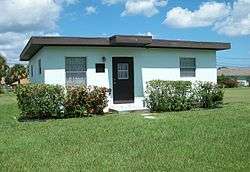Zora Neale Hurston House
The Zora Neale Hurston House is a historic house at 1734 Avenue L in Fort Pierce, Florida. Built in 1957, it was the home of author Zora Neale Hurston (1891-1960) from then until her death. On December 4, 1991, it was designated as a U.S. National Historic Landmark.
Zora Neale Hurston House | |
 | |
  | |
| Location | 1734 Avenue L, Fort Pierce, Florida |
|---|---|
| Coordinates | 27°27′39″N 80°20′31″W |
| Area | less than one acre |
| Built | 1957[1] |
| Built by | Benton, C.C. |
| Architectural style | Frame Vernacular[1] |
| NRHP reference No. | 91002047[2] |
| Significant dates | |
| Added to NRHP | December 4, 1991 |
| Designated NHL | December 4, 1991[3] |
Description and history
The Zora Neale Hurston House stands in a residential area of Fort Pierce, on the north side of Avenue L, between North 17th and North 19th Streets. It is a modest single-story house, built out of concrete blocks stuccoed exterior and a flat tar-and-gravel roof. The house is not architecturally distinguished; it was one of a number of identical homes built in 1957 built by Dr. C.C. Benton, a medical doctor, who had sold 10 nearby acres for construction of "a new negro high school" nearby. Originally located on School Court,[4] it was moved, retaining orientation, north 500 feet in 1995 to 1734 Avenue L to allow for expansion of Lincoln Park Academy, the school at which Hurston taught.[5]
Hurston, a native of Florida, was one of the leading female African-American writers of the mid-20th century. She lived rent-free (courtesy of Dr. Benton) in this house from 1957 until her death. While here, she worked as a journalist for the Fort Pierce Chronicle, taught at the academy, and continued to work on her manuscript for Herod the Great, a major work that remained unpublished at her death. This house is the only known home of hers to survive.[4]
The house is a stop on the Zora Neale Hurston Dust Tracks Heritage Trail.[6] Other stops on the trail include the Zora Neale Hurston Branch Library, a "Zora Exhibit" at the Agape Senior Recreation Center (formerly the St. Lucie County Welfare Home, where Hurston died in 1960), and the Garden of Heavenly Rest Cemetery where she is buried.[6]
See also
References
- "St. Lucie County listings". Florida's History Through Its Places. Florida's Office of Cultural and Historical Programs. 2007-09-22. Archived from the original on March 10, 2007.
- "National Register Information System". National Register of Historic Places. National Park Service. July 9, 2010.
- Hurston, Zora Neale, House at National Historic Landmarks Program Archived September 27, 2007, at the Wayback Machine
- Dr. Page Putnam Miller (June 19, 1991). "National Historic Landmark Nomination: Hurston, Zora Neale House". and accompanying three photos from 1989
- Zora Neale Hurston Dust Tracks Heritage Trail: Zora Neale Hurston House Archived February 19, 2008, at the Wayback Machine.
- "Zora Neale Hurston Dust Tracks Heritage Trail | Fort Pierce, FL - Official Website". www.cityoffortpierce.com. Retrieved 2017-02-23.
External links
- Famous Floridians of Fort Pierce at Florida's Office of Cultural and Historical Programs
- at the St. Lucie County Library System
| Wikimedia Commons has media related to Zora Neale Hurston House. |

